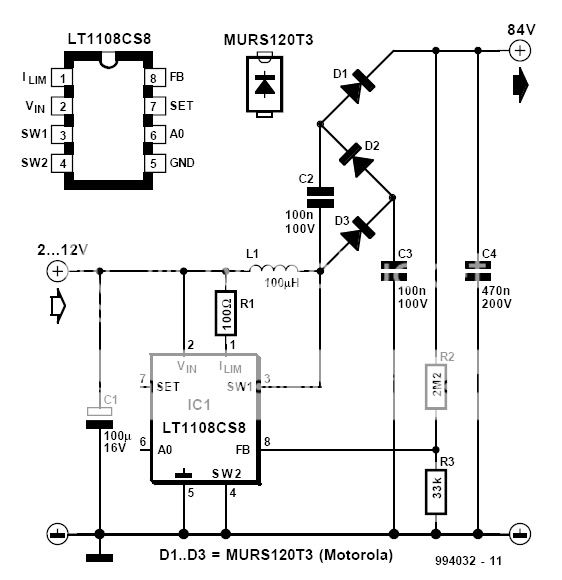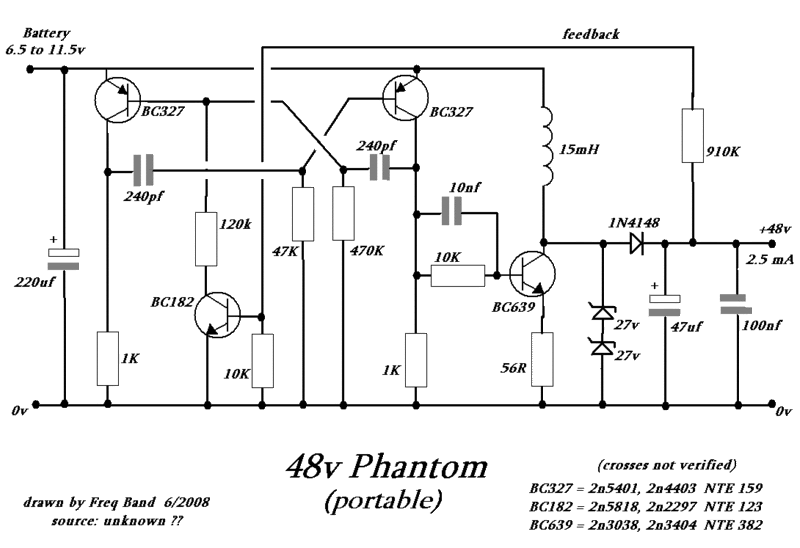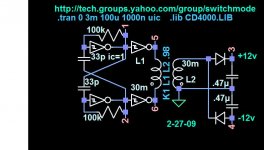Hello to everyone,
I have to make the power supply for a mic pre amp.
This preamp must be portable so I'd like to supply it with a battery.
In some commercial preamp with one 9V battery they obtain the voltage for the ICs (+/-18V) and also +48V for the phantom power.
I make some googling but I don't find nothing
Could anyone help me with some schematics?
I don't want to use trafo and if it's possible the ICs used have to be DIP (no surface mount integrate).
Thanks.
Andrea
I have to make the power supply for a mic pre amp.
This preamp must be portable so I'd like to supply it with a battery.
In some commercial preamp with one 9V battery they obtain the voltage for the ICs (+/-18V) and also +48V for the phantom power.
I make some googling but I don't find nothing
Could anyone help me with some schematics?
I don't want to use trafo and if it's possible the ICs used have to be DIP (no surface mount integrate).
Thanks.
Andrea
You can use an SG3524 or SG3525 pulse width modulator chip to boost the 9V with a push-pull DC-DC converter. Since it is for a microphone circuit you will need to clean up the output with a linear regulator (for which you will need to boost the output about 1.5V over what you need to end up with.) Elliot Sound Products has a number of designs with the SG3524 -- folks use them to power mobile electronics all the time.
Unfortunately, you need a fair amount of inductance for a relatively low current demand on the dc-dc converter.
You can use LM317/LM337 for cleaning up the +/-18VDC, and a TL783 or LM317HV for the +48VDC. Make sure that the power supply box is well shielded, probably want to put some ferrite beads on the power lines.
Unfortunately, you need a fair amount of inductance for a relatively low current demand on the dc-dc converter.
You can use LM317/LM337 for cleaning up the +/-18VDC, and a TL783 or LM317HV for the +48VDC. Make sure that the power supply box is well shielded, probably want to put some ferrite beads on the power lines.
Thanks!
but I prefer to use an IC because the preamp and the power supplymust be inserted in the same enclousure and it's difficult, for me, to make the cores.
I'va found this schematic

changing the value of R2 and R3 I could obtain any voltage.
Is this schematic suitable for my project?
Thanks
but I prefer to use an IC because the preamp and the power supplymust be inserted in the same enclousure and it's difficult, for me, to make the cores.
I'va found this schematic

changing the value of R2 and R3 I could obtain any voltage.
Is this schematic suitable for my project?
Thanks
jeppix said:Thanks!
but I prefer to use an IC because the preamp and the power supplymust be inserted in the same enclousure and it's difficult, for me, to make the cores.
I'va found this schematic
changing the value of R2 and R3 I could obtain any voltage.
Is this schematic suitable for my project?
Thanks
You can try it, step-up converters of this type are a bit "noisy" -- virtually all of the big IC houses make chips which willl work -- you might want to take a look at the various design tools which Texas Instruments, National Semiconductor, Linear Tech (whose chip you have shown above). etc.
How much "volume" do you have to work with?
I think the best way to get portable phantom power would be to use 5 9V batteries in series. That would give 45v not 48v but 45v is high enough to work. It should perform very well compared to switching ICs which might be too noisy. I imagine the battery life will be quite bad with a single 9v battery and step up IC as well.
sivan_and said:Why don't u try with white LED boost regulators..they r more flexible..try linear technology web site for drivers upto 10 Led's by modifying the circuit around feedback u get phantom power with current limit..but am not sure abt noise.
LTC3783
Better yet -- if you can pull down the August 7, 2008 article from EDN:
"High voltage, low noise dc/dc converters" by Jim Williams -- all will be clear.
Unfortunately the maximum efficiency of charge pump solutions (the ones based in diodes and capacitors only) is 50%. They waste at least as much battery energy as they deliver to the load.
The most efficient way to do it is a flyback SMPS with a small transformer.
Unfortunately, again, 48V phantom power and +/-18V rails would result in short battery life because a lot of energy is wasted in the op-amps and sometimes in the microphones when they contain active circuits drawing current from 48V to ground.
The 48V alone may be easily obtained from 9V through a boost converter using a standard axial inductor and no transformers. There are specific control ICs that waste very little power.
For signal amplification you may consider low-power op-amps fed directly from 9V in order to achieve reasonable battery life. The output op-amp may be "rail-to-rail" type if you really need +/-9V swing (unlikely).
The most efficient way to do it is a flyback SMPS with a small transformer.
Unfortunately, again, 48V phantom power and +/-18V rails would result in short battery life because a lot of energy is wasted in the op-amps and sometimes in the microphones when they contain active circuits drawing current from 48V to ground.
The 48V alone may be easily obtained from 9V through a boost converter using a standard axial inductor and no transformers. There are specific control ICs that waste very little power.
For signal amplification you may consider low-power op-amps fed directly from 9V in order to achieve reasonable battery life. The output op-amp may be "rail-to-rail" type if you really need +/-9V swing (unlikely).
Hello all-
Have you thought about the fact that you may not actually need a true 48VDC for the microphone you're using to actually work properly? Many very high-end units use a phantom voltage well below the 48V standard and work just fine. I have run Schoeps CMC6 microphones and AKG 414-TLII mics on 12VDC phantom power without issues. Like was previously said here, not every microphone uses phantom power for the same things, some just use it as a capsule bias voltage, and others use if for this and to power a built-in preamplifier or FET buffer circuit. These that have built-in circuitry almost always need higher voltage or current. You should have a look at the spec sheets for the mics you'll be using with this preamp, maybe you don't need a voltage above 18VDC at all.
Many portable mixers like the Shure FP-33 have switchable phantom power voltages, either 12V or 48V. They do this with just two standard 9V batteries in series, and this gives you about 6 hrs. battery life even when powering three microphones from it.
Maybe the Shure FP-33 schematics would be worth a look? I don't know if it's available from Shure, I didn't see it on their website.....
HTH
Have you thought about the fact that you may not actually need a true 48VDC for the microphone you're using to actually work properly? Many very high-end units use a phantom voltage well below the 48V standard and work just fine. I have run Schoeps CMC6 microphones and AKG 414-TLII mics on 12VDC phantom power without issues. Like was previously said here, not every microphone uses phantom power for the same things, some just use it as a capsule bias voltage, and others use if for this and to power a built-in preamplifier or FET buffer circuit. These that have built-in circuitry almost always need higher voltage or current. You should have a look at the spec sheets for the mics you'll be using with this preamp, maybe you don't need a voltage above 18VDC at all.
Many portable mixers like the Shure FP-33 have switchable phantom power voltages, either 12V or 48V. They do this with just two standard 9V batteries in series, and this gives you about 6 hrs. battery life even when powering three microphones from it.
Maybe the Shure FP-33 schematics would be worth a look? I don't know if it's available from Shure, I didn't see it on their website.....
HTH
Maybe try this: http://www.monterdiy.vel.pl/?p=118
Phantom step-up converter can by made on LM2577
http://www.national.com/ds/LM/LM1577.pdf
My schematic I add soon, it's simple. 9V battery supply, and 50V on output.
Phantom step-up converter can by made on LM2577
http://www.national.com/ds/LM/LM1577.pdf
My schematic I add soon, it's simple. 9V battery supply, and 50V on output.
Most of the ICs mentioned are completely unsuitable due to the high quiescent current.
Another alternative is to use a PIC with ADC to control three separate boost and flyback regulators, that may operate in "pulse skip" mode to get better efficiency. This avoids the transformer but requires three independent MOSFET and inductors and some programming skills.
Capacitance of 9V alkaline batteries seems to be in the 400mAh range.
Another alternative is to use a PIC with ADC to control three separate boost and flyback regulators, that may operate in "pulse skip" mode to get better efficiency. This avoids the transformer but requires three independent MOSFET and inductors and some programming skills.
Capacitance of 9V alkaline batteries seems to be in the 400mAh range.
Up conversion isn't terribly efficient if the ratio is high, especially if you raise the frequency so you can use smaller components. It can be noisy. The layout is sensitive. The lower the current draw the less the efficiency because it's hard to reduce quiescent consumption below a certain point. Efficiency with a boost converter, maybe 85% if you do everything perfectly. Efficiency with a group of batteries in series, 100%. Don't cut the 48V phantom by too much. Though mics will work on much less, they don't all perform as well as they do at the specified voltage. IMO, a lot of the negative comments I've read on the inexpensive large diaphragm condenser mics now available are a result of running them at reduced voltages.
http://www.moxtone.com/ostalo.htm
With standard condenser microphone (current about 3mA) 9V lithum battery works about 8 hours.
My portable phantom 48V supply:

With standard condenser microphone (current about 3mA) 9V lithum battery works about 8 hours.
My portable phantom 48V supply:

jeppix said:Hello to everybody!
I will try some solutions, in fact my preamp project is based on two pcb; one is the preamp circuit for both chanel and the other will be the power supply so I could test.
If someone find out other solution please tell me and I try
Thanks
The way I would do it is to use a 74C14 (CD40106) in a 16 pin DIP package. It has low quiesent current ratings. It can drive some small signal coupling transformers. The transformers are wound with a lot of fine wire. They have a lot of inductance and about 50 ohms of resistance per winding. They should be quiet for conducted noise. They might need some mechanical shielding.
Here is the basic idea.
Attachments
- Status
- This old topic is closed. If you want to reopen this topic, contact a moderator using the "Report Post" button.
- Home
- Amplifiers
- Power Supplies
- +/-18V & +48V from a battery

